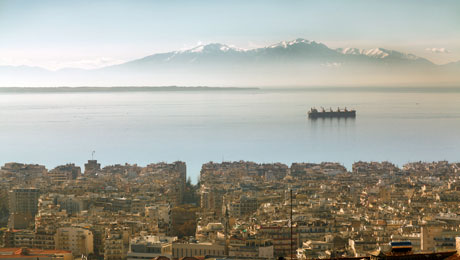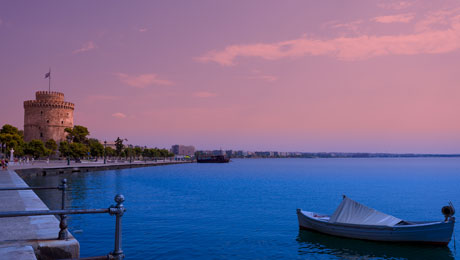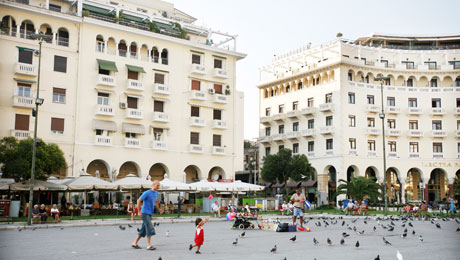Pictures: www.clickatlife.gr
Every September, the political and economic heart of the country beats in the second capital city of Greece, where the Thessaloniki International Fair is organized. This is the most important international annual exhibition in the Balkans. On this occasion, we will walk you around this beautiful city – from the romantic promenade to the fortress and the city centre.
The mother of the poor, the nymph of the Thermaikos Gulf who is praised in many songs, the second capital city - chief town of the Greek north, according to many people, is the loveliest city in Greece. This is a modern urban centre with rich history, significant landmarks and culture, which starts from antiquity.
Built amphitheatrically around the WhiteTower, with a wide sea horizon and an important port, Thessaloniki was founded in 315 BC by Kassandros who named the city after his wife, Thessaloniki, sister of Alexander the Great. Built in an important era for Greek history, when Hellenism began to spread to the east, the city has been offering its embrace to everybody over the centuries – Jews pursued by the Spanish Sephardic in the late 15th century, many Thracians, refugees from Asia Minor after the catastrophe of 1922, as well as external economic immigrants.

Because of the strategic location of the harbour, the city is a key commercial and cultural centre. In 322, Constantine the Great himself built an artificial rectangular port for his fleet, traces of which are still preserved.
Today, Thessaloniki is a big city, the biggest urban centre in northern Greece, and a major point of pan-European road, air and sea communications. Its modern appearance lives alongside multiple historical elements, while managing to maintain a warm, living human appearance all the time.
You can admire the many Byzantine churches in various districts of the city and majestic domes of other Byzantine monuments, archaeological sites, museums and art galleries, or enjoy the remarkable cuisine and nightlife.
The historic centre and the Upper Town (Ano Poli)
Thessaloniki has a wide centre where there are many shops, public offices, monuments and recreation areas. Its historic centre is divided into the following districts: Ladadika, Frangomahalas, Kapani and several others, and the central point is the integrated area of Aristotle Square and the square of the ancient agora (also known as Dikastirion), which are connected by the pedestrian street named Aristoteleos. The shopping centre of Modiano is located in Kapani – this is the central roofed market of the city, combining low prices and variety. There you will find many of the best cafes and restaurants of the city.
The upper town, which was saved from the fires of 1917 and 1980, is located in the northern part of the city and offers stunning views. There are important monuments, such as Eptapyrgio (the SevenTowers), the Osios David church, as well as many traditional buildings and narrow streets covered with stones. There are beautiful taverns where you can try the local cuisine.
The promenade
A walk along the coast is something that you shouldn’t miss. In recent years, the area has been modernized and offers many places of entertainment. You can walk from the hotel to the Macedonia Palace Megara Mouzikis (the Concert Hall) and breathe the Thessaloniki air. The sea view is unique, and Mount Olympus is visible on the horizon. There are many cafes and 5 theme parks, where there are various events and a bike path.
The White Tower

The most famous symbol of the city and its most recognizable monument, the White Tower, was built in the 15th century and is the only surviving Ottoman fortress of the city. It was used as a military building and prison and is now a museum. There are 6 floors, which are connected by an internal staircase, which is 34 metres high. On the top floor, there is a hall and an outdoor balcony that offers spectacular views.
Aristotle Square and Dikastirion Square

Aristotle Square is one of the central squares, and is located at the beginning of the eponymous street on the coast. It is a popular spot both for locals and tourists, with many cafes, shops and hotels. Around it, you can find some of the most important and beautiful buildings of the city, such as Olympion which hosts the Thessaloniki Film Festival.
Dikastirion Square is located near the ancient Roman agora. There, visitors can find the statue of Eleftherios Venizelos and enjoy various events.
The Church of St. Demetrios, the Rotunda and the Arch of Galerius
These are three of the most important landmarks. The Church of St. Demetrios is a Byzantine monument which has been included in UNESCO’s list as a World Heritage Site since 1988. It has mosaics and frescoes dating from the 8th century. You can also visit the crypt of the church, which is now an exhibition space.
The Rotunda was designed to be a mausoleum of Emperor Galerius. Later, it was converted into a Christian church dedicated to St. George and is also on UNESCO’s list. Today, exhibitions are organized there.
